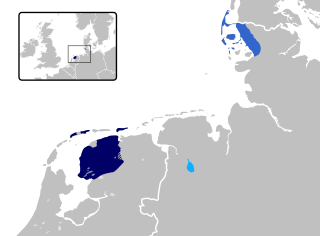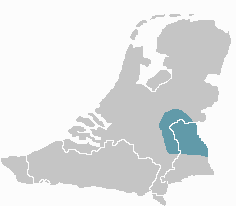Related Research Articles

The Frisian languages are a closely related group of West Germanic languages, spoken by about 400,000 Frisian people, who live on the southern fringes of the North Sea in the Netherlands and Germany. The Frisian languages are the closest living language group to the Anglic languages; the two groups make up the Anglo-Frisian languages group and together with the Low German dialects these form the North Sea Germanic languages. However, modern English and Frisian are not mutually intelligible, nor are Frisian languages intelligible among themselves, owing to independent linguistic innovations and language contact with neighboring languages.

Low Saxon, also known as West Low German are a group of Low German dialects spoken in parts of the Netherlands, northwestern Germany and southern Denmark. It is one of two dialect groups, the other being East Low German.

In historical and comparative linguistics, Low Franconian is a linguistic category used to classify a number of historical and contemporary West Germanic varieties closely related to, and including, the Dutch language. Most dialects and languages included within this category are spoken in the Netherlands, northern Belgium (Flanders), in the Nord department of France, in western Germany, as well as in Suriname, South Africa and Namibia.

Stadsfries or Town Frisian is a set of dialects spoken in certain cities in the province of Friesland in the northern Netherlands, namely Leeuwarden, Sneek, Bolsward, Franeker, Dokkum, Harlingen, Stavoren, and to some extent in Heerenveen. For linguistic reasons, the outlying and insular dialects of Midsland (Terschelling), Ameland, Het Bildt, and Kollum are also sometimes tied to Stadsfries.

Limburgish refers to a group of South Low Franconian varieties spoken in Belgium and the Netherlands, characterized by their distance to, and limited participation in the formation of, Standard Dutch. In the Dutch province of Limburg, all dialects have been given regional language status, including those comprising ″Limburgish″ as used in this article.

Ripuarian or Ripuarian Franconian is a German dialect group, part of the West Central German language group. Together with the Moselle Franconian which includes the Luxembourgish language, Ripuarian belongs to the larger Central Franconian dialect family and also to the linguistic continuum with the Low Franconian languages.

Hollandic or Hollandish is the most widely spoken dialect of the Dutch language. Hollandic is among the Central Dutch dialects. Other important language varieties of spoken Low Franconian languages are Brabantian, Flemish, Zeelandic, Limburgish and Surinamese Dutch.

West-Veluws is a Low Franconian dialect of the Dutch province of Gelderland. It is spoken in several Veluwe municipalities and villages including: Nunspeet, Putten, Ermelo (Armelo), Harderwijk (Harderwiek), Uddel, Nijkerk (Niekark), Appel, Scherpenzeel (Schaarpezeel), the municipality of Barneveld (Barreveld) and some villages of the municipality of Ede.

Veluws is a dialect or an umbrella term for dialects which are spoken in Veluwe, in the northwest of Gelderland, in central Netherlands.
Sallaans is a collective term for the Westphalian dialects of the region Salland, in the province of Overijssel, as well as in minor parts of Gelderland and Drenthe in the Eastern Netherlands, and a small part in the North and the East of Veluwe. In the Kop van Overijssel, the Stellingwarfs dialect is spoken.
Southeast Limburgish is a cover term for the Ripuarian dialects spoken in Dutch Limburg.

The predominant language of the Netherlands is Dutch, spoken and written by almost all people in the Netherlands. Dutch is also spoken and official in Aruba, Bonaire, Belgium, Curaçao, Saba, Sint Eustatius, Sint Maarten and Suriname. It is a West Germanic, Low Franconian language that originated in the Early Middle Ages and was standardised in the 16th century.

Kleverlandish is a group of Low Franconian dialects spoken on both sides of the Dutch-German border along the Meuse and Rhine rivers.
Dutch dialects and varieties are primarily the dialects and varieties that are both cognate with the Dutch language and spoken in the same language area as the Standard Dutch. They are remarkably diverse and are found within Europe mainly in the Netherlands and northern Belgium.

Dutch is a West Germanic language, spoken by about 25 million people as a first language and 5 million as a second language and is the third most spoken Germanic language. In Europe, Dutch is the native language of most of the population of the Netherlands and Flanders. Dutch was one of the official languages of South Africa until 1925, when it was replaced by Afrikaans, a separate but partially mutually intelligible daughter language of Dutch. Afrikaans, depending on the definition used, may be considered a sister language, spoken, to some degree, by at least 16 million people, mainly in South Africa and Namibia, and evolving from Cape Dutch dialects.

Oost-Veluws is a Low Saxon dialect of the Dutch province of Gelderland. The dialect is endangered as there are few native speakers left.

Friso-Saxon is a group of West Germanic dialects found around the North Sea coast of the Netherlands and Germany, in an area historically known as Frisia. They are dialects of Low German/Low Saxon that have experienced strong influence from a Frisian language.

Flemish (Vlaams) is a Low Franconian dialect cluster of the Dutch language. It is sometimes referred to as Flemish Dutch, Belgian Dutch, or Southern Dutch. Flemish is native to the region known as Flanders in northern Belgium; it is spoken by Flemings, the dominant ethnic group of the region. Outside of Belgium Flanders, it is also spoken to some extent in French Flanders and the Dutch Zeelandic Flanders.
References
- 1 2 3 4 5 6 7 8 9 10 Wilbert (Jan) Heeringa, Chapter 9: Measuring Dutch dialect distances, of the doctor's thesis: Measuring Dialect Pronunciation Differences using Levenshtein Distance, 2004 (thesis, chapter 9 (PDF))
- ↑ Wilbert Heeringa, John Nerbonne, De analyse van taalvariatie in het Nederlandse dialectgebied: methoden en resultaten op basis van lexicon en uitspraak, 2006 (
- ↑ Nerbonne, John. "De analyse van taalvariatie in het Nederlandse dialectgebied methoden en resultaten op basis van lexicon en uitspraak".
{{cite journal}}: Cite journal requires|journal=(help)